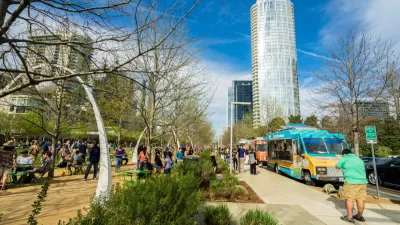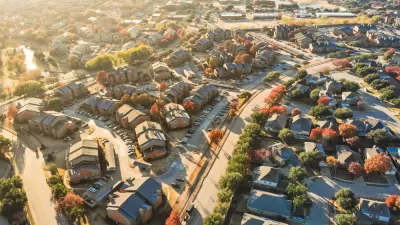The land use plan outlines ambitious goals for the city’s future, but offers little in the way of concrete changes.

In an article for Dallas Weekly, Sam Judy describes the potential of Dallas’ ForwardDallas land use plan, which is making its way to the City Council for final approval.
The proposal lays out a framework for “equity, environmental justice, and affordability for both renters and homebuyers,” but holds no regulatory power of its own.
“As the plan calls for ‘gentle density’ along transportation corridors throughout the city, single-family neighborhoods could be under threat of gentrification as middle housing such as duplexes and triplexes are integrated into neighborhoods within a mostly unregulated housing market,” Judy explains.
Critics of the plan also point out that it includes “minimal regulations on rental and housing fees” and uses a higher-than-usual base value for what qualifies as affordable housing.
A HUD representative said “ForwardDallas does not directly address affordable housing. It does recommend accommodating more housing throughout the city, where appropriate, to provide more housing options for all.” Unlike other cities, Dallas is not implementing “policies addressing the inverse drawbacks [of ForwardDallas] to ensure housing remains accessible.” Texas law complicates local housing policy, as it prohibits cities from establishing rent controls except under specific circumstances.
The plan includes some wins for environmental groups. Changes to land use in West Dallas could push out industrial development and promote cleaner commercial industry instead.
For Judy, “The goals it strives for are too general, whilst laid within a framework too loose. It states ambitions that our current city government has never meaningfully ventured toward. Dallas lacks the necessary regulation to address issues outlined in the plan, such as affordability and equity.”
FULL STORY: ForwardDallas Explained: How the Land Use Plan Can (and Cannot) Change the City

Study: Maui’s Plan to Convert Vacation Rentals to Long-Term Housing Could Cause Nearly $1 Billion Economic Loss
The plan would reduce visitor accommodation by 25,% resulting in 1,900 jobs lost.

North Texas Transit Leaders Tout Benefits of TOD for Growing Region
At a summit focused on transit-oriented development, policymakers discussed how North Texas’ expanded light rail system can serve as a tool for economic growth.

Alabama: Trump Terminates Settlements for Black Communities Harmed By Raw Sewage
Trump deemed the landmark civil rights agreement “illegal DEI and environmental justice policy.”

How Community Science Connects People, Parks, and Biodiversity
Community science engages people of all backgrounds in documenting local biodiversity, strengthening connections to nature, and contributing to global efforts like the City Nature Challenge to build a more inclusive and resilient future.

Alabama: Trump Terminates Settlements for Black Communities Harmed By Raw Sewage
Trump deemed the landmark civil rights agreement “illegal DEI and environmental justice policy.”

Dear Tesla Driver: “It’s not You, It’s Him.”
Amidst a booming bumper sticker industry, one writer offers solace to those asking, “Does this car make me look fascist?”
Urban Design for Planners 1: Software Tools
This six-course series explores essential urban design concepts using open source software and equips planners with the tools they need to participate fully in the urban design process.
Planning for Universal Design
Learn the tools for implementing Universal Design in planning regulations.
City of Santa Clarita
Ascent Environmental
Institute for Housing and Urban Development Studies (IHS)
City of Grandview
Harvard GSD Executive Education
Toledo-Lucas County Plan Commissions
Salt Lake City
NYU Wagner Graduate School of Public Service




























